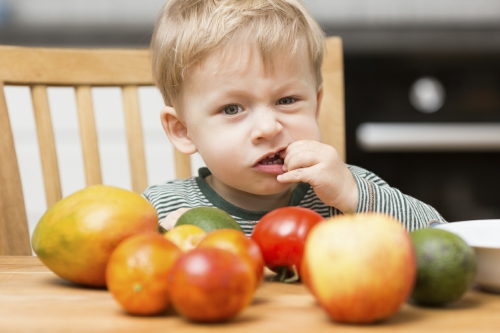Picky eaters ate less dietary fibre than the UK recommended amount and more than a quarter (29 per cent) of them usually had hard stools. The food group the picky eaters avoided most was vegetables, eating about half the amount non-picky eaters did. They also ate less fruit, but this was less marked than for vegetables.
Even the children who weren’t picky eaters didn’t eat enough dietary fibre. Overall, about three quarters of the children surveyed consumed less than the amount of dietary fibre provisionally recommended for the age group in the UK by the Scientific Advisory Committee on Nutrition (about 15 g per day). This rose to 85 per cent of picky eaters not eating enough fibre. The main sources of fibre were bread (19 per cent), vegetables (16 per cent) and fruit (nine per cent).
The current UK recommended intake of fruit and vegetables for health is five portions a day. Based on the relative energy intake of a three-year-old child compared with an adult, this would equate to approximately 250 g a day (for example, one medium banana plus 10 grapes, four broccoli florets, six carrot sticks and four plum tomatoes over a day).
The mean total weight of fruit and vegetables consumed by non-picky eaters was approximately 120 g a day, half the recommended amount. The picky children were eating a mean total weight of approximately 74 g of fruit and vegetables a day – less than one-third of the recommendation.
Having hard stools is one of the symptoms of constipation described in the UK’s National Institute for Health and Clinical Excellence (NICE) guidelines on constipation in children. Picky eaters were 30 per cent more likely to have hard stools than non-picky eaters.
In this study, the researchers found dietary fibre intake was associated with hard stools in all the children and particularly in the picky eaters, suggesting increasing fibre intake in the whole group could lead to improved bowel habits.
Dr Caroline Taylor, who led the research said: "Our research highlights the need to increase the fibre intake in the majority of children, particularly by increasing the amount of veg and fruit they eat.
"For parents of children who are picky eaters, the best advice is to try a combination of approaches, including offering small tastes of vegetables on many occasions to overcome neophobia (fear of what is new), showing a good example by eating vegetables themselves, and by having regular family mealtimes with the same meal offered to but not forced on everyone."
Paper
‘Picky eating in preschool children: Associations with dietary fibre intakes and stool hardness’ by Caroline M. Taylor, Kate Northstone, Susan M. Wernimont and Pauline M. Emmett in Appetite [open access]
